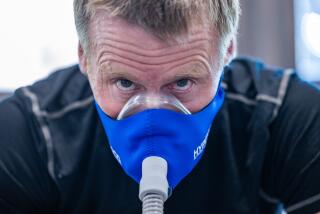Lightening the Load for Backpackers
- Share via
Common-sense measures are probably better than medication to prevent acute mountain sickness in recreational backpackers, suggest two researchers in the current issue of the Western Journal of Medicine.
To determine the best treatment for acute mountain sickness (AMS), a mild form of high-altitude illness sometimes experienced by those who ascend rapidly to altitudes above 8,000 feet, the researchers compared the use of acetazolamide (Diamox), dexamethasone acetate (Decadron), a combination of the two drugs and placebo treatment in 32 healthy backpackers. AMS symptoms can include headache, lightheadedness, nausea, insomnia and anorexia.
Frequent Side Effects
The backpackers climbed to elevations above 13,000 feet and slept at an altitude of 12,000 feet, wrote the researchers, Drs. Steven C. Zell and Philip H. Goodman of the department of medicine, Veterans Administration Medical Center, University of Nevada School of Medicine in Reno.
Side effects caused by the two drugs were frequent enough “to preclude the routine use of acetazolamide or dexamethasone” in prevention of AMS, the researchers concluded. Backpackers who took acetazolamide suffered taste disturbances and numbness of the hands, wrote the doctors, and those who took dexamethasone acetate experienced depression, fatigue and insomnia.
In lieu of drugs, Zell suggested, recreational climbers ascend slowly and give their bodies a chance to acclimate. “Within the first 24 hours, stay at about 8,000 feet elevation or less. Once you go above that, the amount of oxygen in the blood decreases rapidly.”
The old adage “Climb high, sleep low” is a good one, Zell added. “If you want to go to high altitudes during the day, that may be fine. But return to lower altitudes at night until you’ve been two or three days in the mountains. And keep hydrated.”
Nutrition and the Elderly
Nutrition-poor diets are the rule for one-fifth of men over age 55 and a quarter of women over age 55 who live alone, according to a UC San Francisco study that used U.S. Department of Agriculture data on 4,400 people.
In general, older women had poorer diets than men, say UCSF researchers who reported the data at a recent meeting of the Federation of American Societies for Experimental Biology.
Their recommendations? Cut down on fat intake and eat more foods that are richer in vitamins and minerals such as fruits, vegetables and whole grains.
Joan Levinthal, a Tarzana registered dietitian who also has studied diets of the elderly, had these suggestions: Instead of a doughnut--”a typical breakfast choice for the elderly”--eat cereal like oatmeal or Shredded Wheat or poached or scrambled eggs and some orange juice.
For lunch, skip broth-type soup, which has very little protein, Levinthal suggested, and opt for a soup such as split pea or a grilled cheese or peanut butter sandwich. Have a banana for potassium.
Though convenient, frozen dinners offer “very little protein for the dollar,” Levinthal added. Better choices: baked chicken and potatoes. Barbecue sauce, applesauce and jars of prepared baby fruit (used as a sauce) can help keep food easy to chew and tasty, she said.
Post-Lipectomy Sensation
A study of 50 patients who had undergone suction lipectomy for fat removal, reported recently in the journal Plastic and Reconstructive Surgery, found that all patients initially experienced decreased sensation.
In most patients, wrote Drs. Eugene H. Courtiss and Matthias B. Donelan of the department of surgery at Harvard Medical School, sensation returned to normal within six to eight months.
But in some, decreased sensation lasted up to a year or even longer. In some cases, said the authors (who did evaluations before and after surgery), patients had decreased sensation before the surgery but had been unaware of it.
“The larger the treated area, the greater is the sensory loss and the slower is the return,” wrote the physicians who don’t believe lipectomy permanently damages sensory nerves.
IUD Clarification
The Copper T 380A, recently approved by the Food and Drug Administration, and the Progestasert, available for more than a decade, are both intrauterine devices. But they work differently to prevent conception.
“The Progestasert is different from the other IUD now available because it contains progesterone,” said Dr. W. Benson Harer, a San Bernardino gynecologist and district chairman for the American College of Obstetricians and Gynecologists. “The hormone (progesterone) affects the lining of the uterus and it is the main reason for its contraceptive effectiveness.”
The Copper T 380A releases copper. “The copper ions (help) render the environment unfavorable for contraception,” Harer added.
How IUDs act as contraceptives is not entirely understood. They create irritation in the lining of the uterus and make the environment unfavorable for the egg to implant, experts believe. They may also impede fertilization, experts say.
The Copper T 380A is expected to last four years; the Progestasert life span is about a year, according to spokesmen for the manufacturers.






